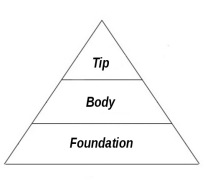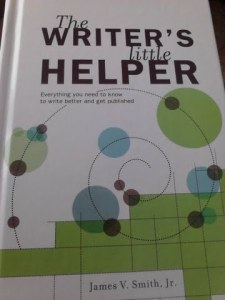 I’ll start this review by saying that ‘pyramid’ just refers to the format I’ve decided to use for this, and all future book reviews on my blog. I’ll be dividing into three parts, represented by the levels of the pyramid seen here. The foundation will discuss what I perceive to be the core of the book, the most important part(s). The body is the stuff that’s important but not quite as important as the foundation, and the tip will be all the nit-picking for stuff that may or may not have added something a little extra to the book, but wouldn’t necessarily have been missed had they been left out.
I’ll start this review by saying that ‘pyramid’ just refers to the format I’ve decided to use for this, and all future book reviews on my blog. I’ll be dividing into three parts, represented by the levels of the pyramid seen here. The foundation will discuss what I perceive to be the core of the book, the most important part(s). The body is the stuff that’s important but not quite as important as the foundation, and the tip will be all the nit-picking for stuff that may or may not have added something a little extra to the book, but wouldn’t necessarily have been missed had they been left out.
Each section will have a rating: Strong, Adequate, or Weak. The terms are fairly self explanatory but if you’re the kind of person who likes a star system, you can think of Strong as 3 stars out of 3, Adequate as 2 out of 3, and Weak as 1.
One last word before diving in the review: I don’t enjoy slamming people’s work, so I generally don’t spend time giving attention to things I don’t enjoy. As a result, the majority of reviews on here are probably going to be on the positive side. It’s not that I’m an easy mark and just love everything I read, it’s just that I don’t want to talk much about the stuff I don’t love. Every now and then if I manage to find some silver lining I deem worthy of sharing, or on the rare occasion I think something is so bad that I feel it’s my civic duty to warn the general public, I’ll share it via my reviews. A basic rule of thumb though is that if I’m featuring it on my blog, I’d recommend you to read it. Ok, with all that out of the way, on with the show.
Title: The Writer’s Little Helper
Author: James V. Smith Jr.
Publisher: Writer’s Digest Books
The Foundation – STRONG
The core strength of this book is far and away its formatting and how the information is presented. This is a reference book meant to be taken off the shelf again and again as your reach different stages in the writing process and is set up in a way that allows you to find what you’re looking for quickly and easily. Everything is classified as either a Tool (a tip or trick you can use, often accompanied by a physical chart or something of that nature you’re meant to photocopy and physically use while writing), a Checklist (there are A LOT of checklists in this book, all of them designed to help you stay on point so you don’t miss something along the way), or a Q&A (a collection of FAQs of writing advice). It makes everything really easy to follow and find when you’re looking for that one specific bit of information.
It also makes the information easy to digest. I can’t recall any specific tip or section lasting for more than 4 pages, most of them lasting for just two, and always on facing pages so you don’t have to spend time flipping through. This kind of design is to help you stay writing, which is critical for success.
I also have to mention the content itself, because without strong content, it doesn’t really matter how it’s formatted. The advice in this book is top notch, easy to understand, and gets you excited to try it in your own writing. The side of each page has a colored tab that clearly tells you what aspect of writing is being discussed. Character, point of view, editing, getting your book published, and pacing are just a few of the myriad of topics covered. It isn’t a book that’s going to take you down to the depths of one specific area, it’s a water-bug that skims across the entire lake.
The Body – STRONG
Supporting the content is the author’s voice. Mr. Smith manages to deliver technical/text-book like advice in an easy, entertaining manner. I often found myself laughing out loud at parts, which doesn’t happen all that often in writing how-to books. One of my favorite parts was his guaranteed advice on how-to write a best-seller. “Copy your favorite best-selling author’s novel word-for-word. By hand. Longhand that is.” This kind of tongue in cheek humor ran throughout the book and I found it highly amusing. I also found it quite amazing when he turned his humor into sound advice. He was serious about copying that best-seller word for word. You’ll have to check the book out to find out why (and no, he’s not part of a dark cult of writers who secretly advocate plagiarism…at least I don’t think he is). Overall, it made it an entertaining read, and gave it a kind of ‘page-turning’ appeal usually found in good stories.
The Tip – STRONG
This book didn’t have all that many nits to pick for me. It’s obvious that the author and publisher had a clear idea of what they wanted this book to be, and they took all the steps necessary to hit that goal. Outside of the content and how it was structured though, this is just a pretty book to look at. I admit that I have a bit of ADOS (Attention Deficit OOOH Shiny!) and it doesn’t take much to make me happy in artistic terms. This book had a lot of color and I love color. Bright colors make me happy, and The Writer’s Little Helper had them in abundance, without being too garish or looking like a clown threw up on the pages. The design and overall look of the pages drew me in and kept my attention, and you really can’t ask for more from a design than that.
I’ve read dozens of books of writing advice and this one will forever rank as one of my favorites. The only slight caveat I have to offer is that this book touts itself as one that can help any writer from the seasoned professional to the beginning writer. While I do agree that the advice contained within can help absolutely anyway, it still FEELS like a book that’s geared towards the beginner. But, everyone can do with a refresher of the basics, or a fresh take on the things they already know, so this book would be a valuable asset for any writer to have on their shelves.

Buy the Book: Amazon, B&N, Writer’s Digest Store
Follow the Author on Twitter: @aVeteranWriter
Follow Writer’s Digest on Twitter: @WritersDigest
Follow me on Twitter: @thewritepursuit
